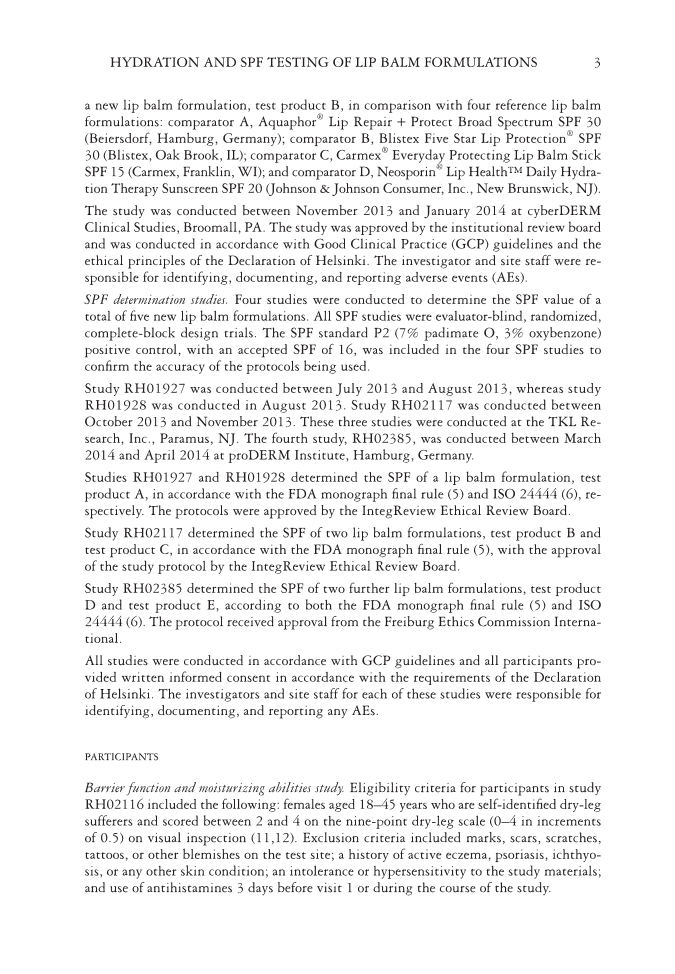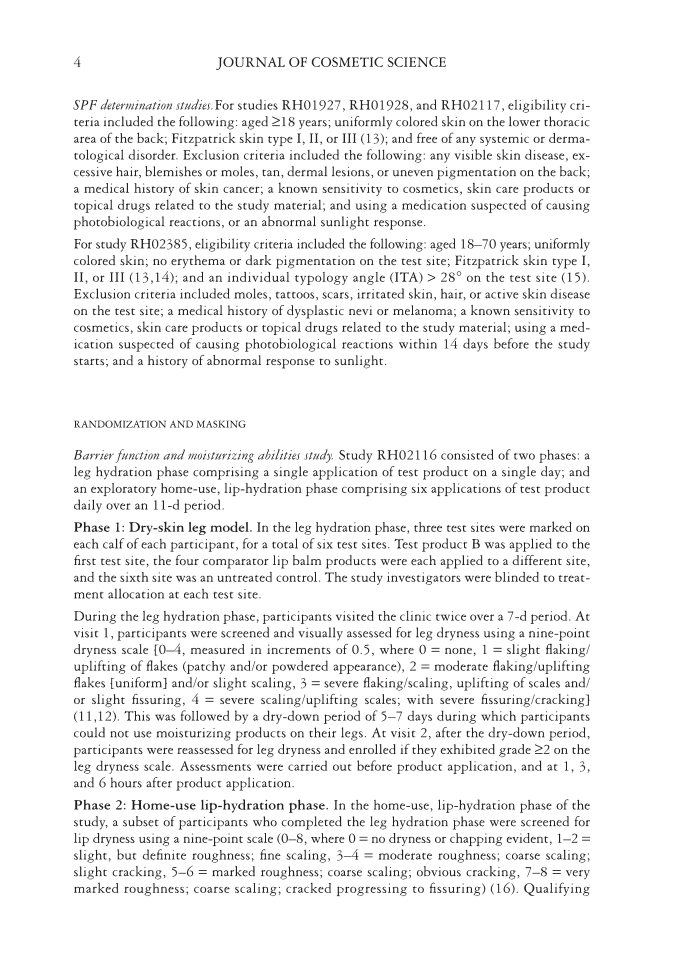HYDRATION AND SPF TESTING OF LIP BALM FORMULATIONS 3 a new lip balm formulation, test product B, in comparison with four reference lip balm formulations: comparator A, Aquaphor® Lip Repair + Protect Broad Spectrum SPF 30 (Beiersdorf, Hamburg, Germany) comparator B, Blistex Five Star Lip Protection® SPF 30 (Blistex, Oak Brook, IL) comparator C, Carmex® Everyday Protecting Lip Balm Stick SPF 15 (Carmex, Franklin, WI) and comparator D, Neosporin® Lip Health™ Daily Hydra- tion Therapy Sunscreen SPF 20 (Johnson & Johnson Consumer, Inc., New Brunswick, NJ). The study was conducted between November 2013 and January 2014 at cyberDERM Clinical Studies, Broomall, PA. The study was approved by the institutional review board and was conducted in accordance with Good Clinical Practice (GCP) guidelines and the ethical principles of the Declaration of Helsinki. The investigator and site staff were re- sponsible for identifying, documenting, and reporting adverse events (AEs). SPF determination studies. Four studies were conducted to determine the SPF value of a total of fi ve new lip balm formulations. All SPF studies were evaluator-blind, randomized, complete-block design trials. The SPF standard P2 (7% padimate O, 3% oxybenzone) positive control, with an accepted SPF of 16, was included in the four SPF studies to confi rm the accuracy of the protocols being used. Study RH01927 was conducted between July 2013 and August 2013, whereas study RH01928 was conducted in August 2013. Study RH02117 was conducted between October 2013 and November 2013. These three studies were conducted at the TKL Re- search, Inc., Paramus, NJ. The fourth study, RH02385, was conducted between March 2014 and April 2014 at proDERM Institute, Hamburg, Germany. Studies RH01927 and RH01928 determined the SPF of a lip balm formulation, test product A, in accordance with the FDA monograph fi nal rule (5) and ISO 24444 (6), re- spectively. The protocols were approved by the IntegReview Ethical Review Board. Study RH02117 determined the SPF of two lip balm formulations, test product B and test product C, in accordance with the FDA monograph fi nal rule (5), with the approval of the study protocol by the IntegReview Ethical Review Board. Study RH02385 determined the SPF of two further lip balm formulations, test product D and test product E, according to both the FDA monograph fi nal rule (5) and ISO 24444 (6). The protocol received approval from the Freiburg Ethics Commission Interna- tional. All studies were conducted in accordance with GCP guidelines and all participants pro- vided written informed consent in accordance with the requirements of the Declaration of Helsinki. The investigators and site staff for each of these studies were responsible for identifying, documenting, and reporting any AEs. PARTICIPANTS Barrier function and moisturizing abilities study. Eligibility criteria for participants in study RH02116 included the following: females aged 18–45 years who are self-identifi ed dry-leg sufferers and scored between 2 and 4 on the nine-point dry-leg scale (0–4 in increments of 0.5) on visual inspection (11,12). Exclusion criteria included marks, scars, scratches, tattoos, or other blemishes on the test site a history of active eczema, psoriasis, ichthyo- sis, or any other skin condition an intolerance or hypersensitivity to the study materials and use of antihistamines 3 days before visit 1 or during the course of the study.
JOURNAL OF COSMETIC SCIENCE 4 SPF determination studies.For studies RH01927, RH01928, and RH02117, eligibility cri- teria included the following: aged ≥18 years uniformly colored skin on the lower thoracic area of the back Fitzpatrick skin type I, II, or III (13) and free of any systemic or derma- tological disorder. Exclusion criteria included the following: any visible skin disease, ex- cessive hair, blemishes or moles, tan, dermal lesions, or uneven pigmentation on the back a medical history of skin cancer a known sensitivity to cosmetics, skin care products or topical drugs related to the study material and using a medication suspected of causing photobiological reactions, or an abnormal sunlight response. For study RH02385, eligibility criteria included the following: aged 18–70 years uniformly colored skin no erythema or dark pigmentation on the test site Fitzpatrick skin type I, II, or III (13,14) and an individual typology angle (ITA) 28° on the test site (15). Exclusion criteria included moles, tattoos, scars, irritated skin, hair, or active skin disease on the test site a medical history of dysplastic nevi or melanoma a known sensitivity to cosmetics, skin care products or topical drugs related to the study material using a med- ication suspected of causing photobiological reactions within 14 days before the study starts and a history of abnormal response to sunlight. RANDOMIZATION AND MASKING Barrier function and moisturizing abilities study. Study RH02116 consisted of two phases: a leg hydration phase comprising a single application of test product on a single day and an exploratory home-use, lip-hydration phase comprising six applications of test product daily over an 11-d period. Phase 1: Dry-skin leg model. In the leg hydration phase, three test sites were marked on each calf of each participant, for a total of six test sites. Test product B was applied to the fi rst test site, the four comparator lip balm products were each applied to a different site, and the sixth site was an untreated control. The study investigators were blinded to treat- ment allocation at each test site. During the leg hydration phase, participants visited the clinic twice over a 7-d period. At visit 1, participants were screened and visually assessed for leg dryness using a nine-point dryness scale [0–4, measured in increments of 0.5, where 0 = none, 1 = slight fl aking/ uplifting of fl akes (patchy and/or powdered appearance), 2 = moderate fl aking/uplifting fl akes [uniform] and/or slight scaling, 3 = severe fl aking/scaling, uplifting of scales and/ or slight fi ssuring, 4 = severe scaling/uplifting scales with severe fi ssuring/cracking] (11,12). This was followed by a dry-down period of 5–7 days during which participants could not use moisturizing products on their legs. At visit 2, after the dry-down period, participants were reassessed for leg dryness and enrolled if they exhibited grade ≥2 on the leg dryness scale. Assessments were carried out before product application, and at 1, 3, and 6 hours after product application. Phase 2: Home-use lip-hydration phase. In the home-use, lip-hydration phase of the study, a subset of participants who completed the leg hydration phase were screened for lip dryness using a nine-point scale (0–8, where 0 = no dryness or chapping evident, 1–2 = slight, but defi nite roughness fi ne scaling, 3–4 = moderate roughness coarse scaling slight cracking, 5–6 = marked roughness coarse scaling obvious cracking, 7–8 = very marked roughness coarse scaling cracked progressing to fi ssuring) (16). Qualifying
Purchased for the exclusive use of nofirst nolast (unknown) From: SCC Media Library & Resource Center (library.scconline.org)


























































